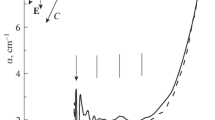Abstract
We report on the results of analysis of optical absorption, EPR signals under optical excitation and magnetic susceptibility of hydrothermal Zn1 –xMnxO single crystals. In the absorption spectra of polarized light at temperatures of 4.2 and 77.3 K, narrow intense a, b, c, and d lines are observed in the energy range 1.877–1.936 eV of light quanta. The spectrum of these lines differs significantly from the spectra of donor and acceptor excitons for ZnO:Co and ZnO:Ni. The intensity of allowed and forbidden EPR signals of the Mn2+(d5) ions does not change under the action of light in the impurity absorption band, while the EPR signals of uncontrollable Fe3+ (d5) ions under illumination practically disappear. New experimental results for Zn1 –xMnxO lead to the conclusion that the d5/d4 donor level of the Mn2+ ion falls into the valence band, while the bandgap of Zn1 –xMnxO contains several dangling bond hybrid (DBH) states due to hybridization of 3d orbitals of the Mn2+ ion with the p-bonds of the nearest O2– oxygen ions. Electron transitions from the DBH states to the conduction band form a broad impurity absorption band of Zn1 –xMnxO, below the edge of which the a, b, c, and d lines referred to as donor excitons [(hloc + d5)e] and emerging as a result of Coulomb interaction of a free s-electron and a hole localized on DBH states (p + d5) are observed. The detection of donor excitons [(hloc + d5)e] makes it possible to study in detail the DBH states in the bandgap, which is important for photocatalysis in the visible light range.








Similar content being viewed by others
REFERENCES
K. A. Kikoin and V. N. Fleurov, Transition Metal Impurities in Semiconductors (World Sci., Singapore, 1994), Part 2, Chaps. 5, 6, 9.
A. Zunger, Solid State Physics, Ed. by F. Seits, H. Ehrenreich, and D. Turnbull (Academic, New York, 1986), Vol. 39.
B. Clerjaud, J. Phys. C 18, 3615 (1985).
V. I. Sokolov and K. A. Kikoin, Sov. Sci. Rev. A, Phys. 12, 147 (1989).
V. I. Sokolov, Semiconductors 28, 329 (1994).
F. W. Kleinlein and R. Helbig, Z. Phys. 266, 201 (1974).
S. G. Gilliland, J. A. Sans, J. F. Sánches-Royo, G. Almonacid, and A. Segura, Appl. Phys. Lett. 96, 241902 (2010).
C. A. Johnson, K. R. Kittelstved, T. C. Kaspar, T. C. Droubay, S. A. Chambers, G. M. Salley, and D. R. Gamelin, Phys. Rev. B 82, 115202 (2010).
M. Godlewski, A. Wojcik-Glodowska, E. Guziewicz, S. Yatsunenko, A. Zakrzewski, Y. Dumont, E. Chikoidze, and M. R. Phillips, Opt. Mater. 31, 1768 (2009).
N. O. Korsunska, I. V. Markevich, T. R. Stara, et al., Ukr. J. Phys. 63 7, 660 (2018).
D. Iuşan, B. Sanyal, and O. Eriksson, J. Appl. Phys. 101, 09H101 (2007).
S. J. Gilliland, J. A. Sans, J. F. Sánchez-Royo, et al., Phys. Rev. B 86, 155203 (2012).
H. Raebiger, S. Lany, and A. Zunger, Phys. Rev. B 79, 165202 (2009).
V. I. Sokolov, N. B. Gruzdev, V. A. Vazhenin, A. V. Fokin, and A. V. Druzhinin, Phys. Solid State 61, 702 (2019).
J. Schneider and S. R. Sircar, Z. Naturforsch. 17a, 570 (1962).
J. Schneider and S. R. Sircar, Z. Naturforsch. 17a, 651 (1962).
D. V. Azamat and M. Fanciulli, Phys. B (Amsterdam, Neth.) 401–402, 382 (2007).
D. V. Azamat, J. Debus, D. R. Yakovlev, et al., Phys. Status Solidi B 247, 1517 (2010).
Yu. S. Kutin, G. V. Mamin, and S. B. Orlinskii, J. Magn. Reson. 237, 110 (2013).
S. A. Al’tshuler and B. M. Kozyrev, Electron Paramagnetic Resonance in Compounds of Transition Elements (Nauka, Moscow, 1972; Halsted, Wiley, New York, 1974).
J. Schneider, Z. Naturforsch. 17a, 189 (1962).
I. P. Kuz’mina and V. A. Nikitenko, Zinc Oxide. Production and Optical Properties (Nauka, Moscow, 1984), p. 168 [in Russian].
A. Ciechan, H. Przybylińska, P. Boguslawski, et al., Phys. Rev. B 94, 165143 (2016).
N. B. Gruzdev, V. I. Sokolov, and G. A. Yemelchenko, J. Low Temp. Phys. 35, 83 (2009).
I. J. Broser, R. K. F. Germer, H.-J. E. Schulz, et al., Solid State Electron. 21, 1597 (1978).
T. Dietl, J. Magn. Magn. Mater. 272–276, 1969 (2004).
C. F. Klingshirn, B. K. Meyer, A. Waag, A. Hoffmann, and J. Geurts, Zinc Oxide. From Fundamental Properties Towards Novel Applications (Springer, Berlin, 2010), Chap. 9.
R. Weidemann, H.-E. Gumlich, M. Kupsch, et al., Phys. Rev. B 45, 1172 (1992).
T. Mizokawa, T. Nambu, A. Fujimori, et al., Phys. Rev. B 65, 085209 (2002).
K. K. Rebane, The Elementary Theory of the Vibrational Structure of the Spectra of Impurity Centers of Crystals (Nauka, Moscow, 1982) [in Russian].
R. D. Shannon, Acta Crystallogr., A 32, 751 (1976).
P. Dahan, V. Fleurov, P. Thurian, et al., J. Phys.: Condens. Matter 10, 2007 (1998).
V. Fleurov, K. Kikoin, and A. Zunger, J. Nanoelectron. Optoelectron. 8, 466 (2013).
I. Di Marco, P. Thunström, M. I. Katsnelson, et al., Nat. Commun. 4, 2645 (2013).
ACKNOWLEDGMENTS
The authors are grateful to V.I. Anisimov, A.V. Lukoyanov, and S.V. Streltsov for discussion of the results of this study.
Funding
This work was performed under a Sate assignment of the Ministry of Education and Science of the Russian Federation (topic “Electron,” no. AAAA-A18-118020190098-5, topic “Magnet,” no. AAAA-A18-11802020290129-5) and under State assignment FEUZ-2020-0054 of the Ministry of Science and Higher Education of the Russian Federation for the Ural Federal University, supported by project no. 18-10-2-6, Ural Branch, Russian Academy of Sciences.
Author information
Authors and Affiliations
Corresponding author
Additional information
Translated by N. Wadhwa
Rights and permissions
About this article
Cite this article
Sokolov, V.I., Gruzdev, N.B., Vazhenin, V.A. et al. Origin of Energy States in the Bandgap of Zn1 –xMnxO. J. Exp. Theor. Phys. 130, 681–689 (2020). https://doi.org/10.1134/S1063776120040123
Received:
Revised:
Accepted:
Published:
Issue Date:
DOI: https://doi.org/10.1134/S1063776120040123




